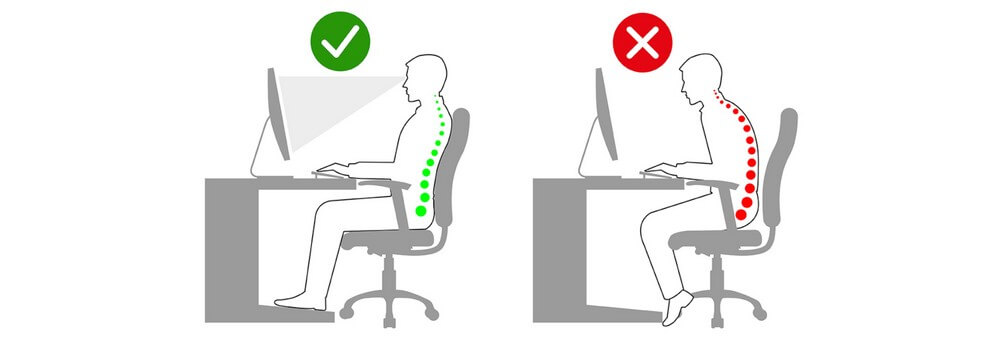
Ergonomic Sitting in the Home Office | Checklist for Healthy Sitting / Ergonomic Workplace
Ergonomic Sitting in the Home Office: Checklist for Healthy Sitting & Tips for an Ergonomic Home Office Setup
Home office work has become an increasingly popular work model in Germany in recent years. However, not everyone is comfortable with the idea of working from home. Most people have a workspace at home, but it is rarely well-equipped. In fact, we often spend more time at our desks in a home office than in a traditional office. For this reason, workplace ergonomics should not only be a concern at corporate offices but also at home. An ergonomic home office setup not only creates a pleasant work atmosphere but also helps you stay focused while working remotely. With proper ergonomics, you can maintain high productivity even when working from home. Here, we explain what you need and how to create an ergonomic home workspace.
Why Ergonomics in the Home Office is Important
Ergonomics focuses on optimizing the interaction between people and their working environment. Ergonomic working conditions aim to create a comfortable work environment, which ideally also improves productivity. Workplace ergonomics are legally regulated under occupational health and safety laws, meaning employers are theoretically responsible for ensuring a healthy work environment, even for remote workers. However, in practice, setting up an ergonomic home office is usually up to the individual. We’ll explain how to do it effortlessly.

Poor sitting posture in the home office can lead to back pain.
Working from home offers the flexibility to work comfortably on your own schedule. However, due to these flexible hours, you may end up sitting at your desk longer than in a traditional office. Poor sitting habits can have long-term health consequences, potentially impacting cognitive function, leading to longer working hours but lower efficiency. To prevent back pain, circulatory issues, and motivational slumps, your workspace should be tailored to your needs. Here’s how to do it properly.
How to Set Up an Ergonomic Home Office
To maintain focus for extended periods, the right office setup is essential. Your office chair, monitor, desk, and other equipment should be chosen according to your work habits and aligned for optimal efficiency. Not everyone enjoys working from home, but the right ergonomic setup can improve comfort and boost productivity.

Your home office should be cozy and well-equipped so that you feel comfortable while working.
For optimal work performance in a home office, it’s important to focus on more than just ergonomic furniture. Other factors also play a role in creating a productive workspace. Consider the following for an ideal home office setup:
- Ergonomic office furniture
- A comfortable room temperature
- Adequate workspace and storage
- Optimal lighting during the day and evening
Ergonomic Chair
Uncomfortable seating is one of the biggest productivity killers when working at a desk. Poor sitting habits due to a lack of movement can lead to physical strain and mental stress over time.
In the home office, prolonged sitting can lead to spinal strain, poor posture, circulatory problems, and even breathing difficulties. Many remote workers end their workday with back and neck pain, which can eventually lead to serious spinal conditions such as herniated discs or scoliosis, as well as chronic posture issues.

Proper sitting posture helps prevent posture-related issues.
An ergonomic office chair can help prevent and even alleviate the effects of poor sitting habits. Small changes in office furniture can encourage a more active and healthy sitting posture, improving both health and work performance.
For long-term comfort and healthy sitting, an ergonomic office chair is essential. To ensure it adapts to your body, it should offer multiple adjustment options and comfortable seating features. When choosing an office chair, consider the following:
- Adjustability: Your chair should be height-adjustable and include adjustable elements such as a customizable backrest, seat height adjustment, and functional armrests for optimal support during long workdays.
- Lumbar Support: A built-in lumbar support helps maintain the spine’s natural curvature, reducing back pain and preventing posture-related issues.
- Adjustable Seat: An ergonomic office chair should have a rounded and tilt-adjustable seat. This promotes position changes and subtly encourages movement throughout the workday. Improved circulation not only helps with concentration but also prevents cardiovascular issues and thrombosis.
- Synchron Mechanism: Chairs with a synchron mechanism adjust dynamically to your movements, providing continuous support through synchronized backrest and seat movements.
With the right ergonomic chair, you’ll experience better support even during the most stressful work situations. Alternatives to ergonomic office chairs include:
- Kneeling chairs
- Stools
- Saddle chairs
- Executive chairs
Our Ergowebshop offers a variety of office chairs that support active sitting. We also provide personal consultations in our store. Our experts can help you find the perfect chair for your home office. If you visit us in person, you can try different models to ensure you select a high-quality ergonomic office chair that meets your needs.
The Right Desk
Poor sitting posture while working is not just caused by an unsuitable office chair but also by a desk that is too small or at the wrong height. A comfortable desk should be at least 160 x 80 cm in size and have a height between 65 cm and 85 cm, providing ample workspace and legroom.
Many modern desks are height-adjustable. Combined with an ergonomic, height-adjustable office chair, you can perfectly tailor your workstation to your body size. Height-adjustable desks can be manually adjusted with a lever or electronically with the press of a button. Ideally, your desk height should align with the armrests of your chair. Standing desks also promote movement, reducing strain on the spine, improving circulation, and enhancing overall comfort during work.
Note: When adjusting your armrests, ensure your arms rest at a 90-degree angle. If your chair does not have armrests, place your arms at a right angle on the desk to maintain proper posture.
The Monitor
The home office is always linked to a digital and flexible work routine. Working with a PC or other devices such as laptops or tablets is essential for home office setups. As a result, the screen of a PC, laptop, or tablet plays a crucial role in both work comfort and ergonomic efficiency. A screen that meets ergonomic standards can prevent issues such as dry eyes, neck and shoulder tension, and migraines, making long hours at the computer more comfortable. The proper use of a screen in a home office is based on several key factors. The most important criteria to consider for your screen are:
- Screen size
- Screen position
- Viewing distance
- Screen height
A larger screen prevents you from constantly leaning forward to see everything clearly. This also helps maintain an optimal viewing distance. The correct distance between your eyes and the monitor depends on the screen size.

Overview of screen sizes and corresponding viewing distances
Note: The table provides general recommendations for working independently on a PC from home. It is also important to consider whether you need to focus on a single section of the screen or view a larger area. For general reading tasks, a viewing distance of 500-650 mm is typically sufficient. Additionally, take your own vision into account when determining the ideal distance between your eyes and the screen.
Incorrect viewing distances can not only reduce productivity but also cause excessive strain on the neck muscles and cervical spine due to unnatural head movements.
Screen Position:
When sitting at your desk, you should be able to see the entire screen with a natural head tilt. This means that, in addition to maintaining the correct viewing distance, the screen should be positioned directly in front of you to avoid constant neck rotation, which can quickly lead to muscle tension and spinal discomfort.
Screen Height:
A screen that is too high or too low forces the neck into unnatural tilting positions. To relieve pressure on the cervical spine, the screen should be at eye level and slightly tilted backward so that your eyes and the screen form a 90° angle.
Keyboard, Mousepads & More: Ergonomic Office Accessories
When working on a PC, constant clicking and typing can lead to strain. After a few hours, it’s no surprise that pain develops in the fingers, wrists, arms, and shoulders. Traditional computer accessories like keyboards and mousepads provide little support, forcing the arms to rest on hard desk surfaces. This results in hand movements being supported only by the wrist and forearm muscles, placing undue stress on these areas. The slightly elevated position of the hands creates an unnatural arm posture that, over time, can cause muscle tension, cramps, and even nerve damage, such as carpal tunnel syndrome.

Man holding an ergonomic computer mouse at his desk.
Ergonomic mice, mousepads, and keyboards provide proper wrist support, preventing the unnatural crossing of the radius and ulna bones. These accessories significantly improve circulation and reduce arm strain.
Note: A more budget-friendly alternative is purchasing a wrist rest for your keyboard and mouse. This helps keep your arm in a natural position, relieving strain on nerves, muscles, and joints during work.
Guide: Setting Up an Ergonomic Workspace
Once you have equipped your home office with ergonomic office furniture and accessories, the next step is to create an optimal working environment for focused and uninterrupted work. While ergonomic furniture is adjustable to meet your needs, a productive and comfortable workspace is essential for maximizing its benefits. The right placement of your ergonomic office equipment influences work behavior and helps establish a structured and organized workspace. The centerpiece of your home office is your desk, where you spend most of your time managing work tasks.

1. Lighting
Proper lighting plays a crucial role in effective work. A workspace that is too dark can lead to poor posture, eye strain, fatigue, and headaches. On the other hand, an overly bright workspace can cause glare, which also leads to discomfort and reduced concentration. To avoid glare or insufficient lighting, place your desk perpendicular to a window. This allows for indirect yet sufficient lighting, helping you stay focused on your work.
Note: During winter, daylight fades quickly. A desk lamp can provide additional lighting. Our web shop offers a variety of affordable and powerful models. Different lighting levels are required depending on vision, task, age, or time of day. Our team of experts is happy to assist in choosing the right lighting for your home office.
2. Space & Organization
A clutter-free and well-lit workspace is key to reducing stress and improving efficiency. Simple organizational habits can significantly enhance productivity. To ensure all your work essentials have a designated place, choose a desk with ample workspace. According to the German Administrative Trade Association (VBG), a home office desk should be at least 160 x 80 cm in size to provide sufficient working space. A spacious desk also encourages active sitting. Having enough legroom promotes movement throughout the day, boosting circulation and concentration.
Keep your workspace organized by positioning your monitor, mouse, keyboard, and documents horizontally to avoid unnecessary head movements, which can lead to neck and shoulder strain.
Note: For better organization, consider using rolling storage cabinets. These provide additional storage in a compact space while keeping essential items within easy reach.
3. Room Temperature
In corporate offices, air conditioning systems help regulate room temperature. However, home offices often lack this feature. Even without climate control, you can create a comfortable work environment at home. Ideally, room temperature should be between 22-23°C for optimal productivity. During summer, indoor temperatures can rise above 26°C, making work uncomfortable. To stay cool on hot days, wear breathable clothing, drink plenty of water, and take advantage of the morning hours for focused work. Morning air circulation can also help refresh the mind and improve concentration.
In winter, room temperatures can drop below 20°C. To maintain a comfortable working environment, use a heater and wear warm clothing to stay cozy without losing focus.
Note: Temperature preferences for hot and cold environments are often a topic of discussion in most office spaces. This can lead to tensions in the work atmosphere and create an uncomfortable office climate. In the home office, you have full control over setting the optimal temperature for your workspace. Without a strict dress code, you can also dress appropriately for the (work) climate without any restrictions.
Checklist: Healthy Sitting in the Home Office
An ergonomic workspace can support healthy sitting in the long run. To protect your back from injuries and poor posture during long workdays, you should analyze your own sitting habits. This is the most effective way to prevent the consequences of prolonged and unhealthy sitting. Many people are unsure what to consider when setting up an ergonomic home office. If you want to use your ergonomic workspace effectively, we have created a short checklist for back-friendly sitting in the home office. Are you sitting correctly? – We have the answer.

Maintaining the correct sitting posture in the home office prevents postural issues and spinal discomfort.
Upright Posture
A slouched back places excessive strain on the lower spine. Sitting in this position for several hours daily can lead to long-term postural damage, painful spinal conditions, and other health issues. To minimize these risks, always ensure that your back remains straight, supporting the spine’s natural shape. An upright sitting posture is achieved when the pelvis is slightly tilted forward while sitting. However, keep in mind that while a straight back helps distribute spinal pressure evenly, it can still lead to muscle fatigue over time without proper support. A well-designed ergonomic chair with a dynamic backrest can provide relief by supporting the spine while maintaining its natural posture.
Arms and Legs at a Right Angle
When sitting on an ergonomic office chair, ensure that your legs are positioned at a right angle with your feet flat on the ground. This promotes proper blood circulation, preventing strain and discomfort. Less bending of the body allows blood to flow more freely, which also improves mental focus. Your upper and lower arms should also form a right angle while resting comfortably on the desk. An ergonomic office chair can help maintain the correct arm and leg positions. The armrests and seat height should be adjusted so that the armrests align with the desk, while your feet remain flat on the floor.
Note: Ergonomics specialists and orthopedic professionals recommend office chairs with a tiltable seat to allow the pelvis to tilt slightly forward, supporting the natural S-curve of the spine. In our online shop, you’ll find office chair models in various price ranges to suit any workspace. Our experts are happy to provide professional advice to help you choose the right office chair—ensuring more movement in your daily work routine.
Active Sitting
Unhealthy sitting habits are often caused by a lack of movement during work. If possible, take breaks to step away from your desk. For instance, take a short walk while on a long phone call or use the stairs instead of the elevator.

Ergonomic sitting in the home office benefits both your health and productivity.
However, movement can also be incorporated into your work routine while sitting. Stretching, leaning back, and adjusting your posture can help improve circulation and release built-up tension in muscles, nerves, and the spine. Regularly changing your sitting position prevents strain from being concentrated on a single area of the spine. An office chair with a rounded or tiltable seat automatically encourages active sitting. These subtle posture changes help prevent neck and shoulder tension, as well as lower back pain, even after a long workday.
Tip: Ideally, you should change your sitting position three to four times per hour. The more often you adjust your posture, the less discomfort you’ll experience. The home office also provides an opportunity to incorporate light exercises at your desk to counteract the strain of a busy workday.
Conclusion
Home office work has become increasingly popular among both employers and employees in the digital age. However, this work model comes with its own set of challenges—including poorly equipped home workspaces. Employees often spend more time at their desks at home than in traditional office settings, as the distinction between work and personal space becomes blurred. As a result, remote workers are at a higher risk of developing unhealthy sitting habits compared to their office-based colleagues.
Fortunately, setting up an ergonomic home office is easier than you think. With the right office furniture, working under unusual conditions can become much more enjoyable. Ergonomic sitting prevents postural issues, back pain, neck and lumbar discomfort, and even serious spinal and circulatory conditions. A proper sitting posture in the home office leads to better focus and efficiency. Even after a long day, maintaining an ergonomic posture ensures you have enough energy for family, friends, and hobbies.
At Profi-Line-Gotha, we offer free, no-obligation consultations on our unbeatable range of ergonomic office equipment—helping you create a professional and balanced home office environment. You can experience our high-quality products firsthand in our showroom. We also provide customized offers tailored to your specific needs and budget. Our experts are here to help. You can reach us in person during business hours, by phone, or via email at info@ergowebshop.de. Alternatively, use our contact form for inquiries.
FAQ:
-
What is the best way to sit in the home office?
For ergonomic sitting in the home office, your office chair, desk, monitor, and PC accessories should be adjusted to suit your sitting habits. The more customizable your office furniture, the better you can maintain a healthy and pain-free sitting posture. Always sit upright with your arms and legs at a 90-degree angle. Movement is key to healthy sitting, and an ergonomic office chair promotes active posture. Our online shop offers a wide selection of ergonomic and orthopedic office chairs. If you visit us in person, you can test different models and receive free professional advice. -
Where should I place my desk in the home office?
When setting up an ergonomic workspace, it is important that your desk is in a comfortable and practical position. Your desk should provide ample working space and be positioned correctly for optimal lighting conditions. Placing your desk perpendicular to a window ensures natural daylight illuminates your workspace without causing screen glare or shadows. The right desk placement helps protect your eyes and prevent headaches. -
What is ergonomic sitting?
Ergonomics is the study of human work environments, aiming to optimize comfort and efficiency. It focuses primarily on proper posture and office furniture. Healthy sitting requires an upright posture with a 90-degree sitting angle. An ergonomic office chair helps maintain this optimal posture by adapting to your body and movement. The goal of ergonomic sitting is to evenly distribute spinal pressure and promote circulation, preventing back and neck pain, as well as circulatory and spinal disorders. -
How high should a desk be in the home office?
For healthy and comfortable sitting, your legs need sufficient space, and your arms should be properly supported. The desk height plays a crucial role in maintaining proper posture. Your desk should be at least 65 cm high, with a maximum height of 85 cm, depending on your body size. A height-adjustable desk from our online shop allows you to adjust the desk to your ideal height with the press of a button. We offer free and no-obligation consultations to help you find the best ergonomic office setup.





